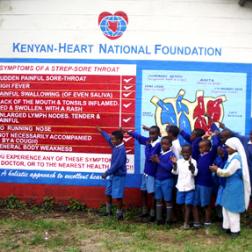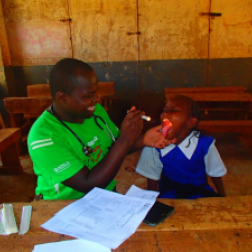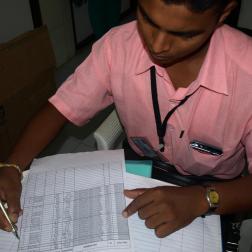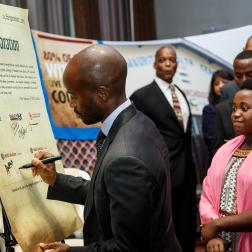Diagnosis
Accurate diagnosis of ARF is vital to enable people to begin secondary prophylaxis and reduce the risk of disease progression. However, underdiagnoses of RF is thought to be widespread and multifactorial.
Case study
In 2006 Lani*, a seven-year-old Fijian girl was taken to her local hospital fifteen times over the course of 18 months. Her complaints of swollen joints and shortness of breath were initially attributed to pneumonia. On her sixteenth visit to the local hospital, a nurse who had attended an RHD workshop run by the World Heart Federation recognized the symptoms of RHD. Lani was immediately transferred to the main hospital, but died hours later from heart failure. An earlier diagnosis of RHD would have allowed Lani to have regular antibiotic injections and treatment, which could have saved her life. Fiji has since invested in a comprehensive RHD control programme but diagnosis and management of RHD remains a worldwide challenge.
*Name changed for privacy
In the absence of a definitive diagnostic test for RF, the disease is diagnosed according to the Jones Criteria or by adapted local guidelines. The Jones Criteria were first developed in 1994 and most recently revised in 2015. In the 2015, the Jones Criteria considers the threshold for ARF diagnosis differently in low risk communities and in moderate-high risk communities and addresses the role of echocardiography in diagnosis. Read 10 points to remember about the revised Jones Criteria or watch Michael Gewitz, lead author of the revised criteria, discuss the update.
|
Diagnosis of initial ARF |
Diagnosis of recurrent ARF |
|
Evidence of preceding GAS infection AND 2 major manifestations OR 1 major plus 2 minor manifestations
|
Evidence of preceding GAS infection AND 2 major manifestations OR 1 major plus 2 minor manifestations OR 3 minor manifestations |
Evidence of preceding GAS infection is defined by the American Heart Association as:
- Increased or rising anti-streptolysin O titer or other streptococcal antibodies (anti-DNASE B). A rise in titer is better evidence than a single titer result.
- A positive throat culture for group A Strep
- A positive rapid group GAS antigen test in a child whose clinical presentation suggests a high pretest probability of streptococcal pharyngitis
|
2015 Jones Criteria Manifestations for Moderate and High Risk Populations |
|
Major Criteria
Minor Criteria
|
|
2015 Jones Criteria Manifestations for Low Risk Populations |
|
Defined as communities with an RF incidence ≤2 per 100 000 school-aged children or all-age rheumatic heart disease prevalence of ≤1 per 1000 population per year. Major criteria
Minor criteria
|
The 2015 Jones Criteria provide technical details, important differential diagnoses and qualifiers for each of these manifestations – the guidelines should be read in full before making definitive diagnosis.
Sydenham's Chorea
One of the unique manifestations of RF is Sydenham’s Chorea – a triad of altered mood, muscle weakness and uncontrollable, discoordinated movements.
This chorea is most common in adolescent women. A major manifestation of RF and often associated with carditis, therefore echo is an essential investigation for patients presenting with chorea. Patients with a history of chorea are considered to be at risk of subsequent cardiac valve damage and should be carefully followed up to ensure they receive secondary prophylaxis.
Because chorea can present as a symptom of RF following a long latent period evidence of preceding GAS infection to confirm diagnosis is not necessary in some jurisdictions, once other causes of chorea are excluded.
Features of Sydenham’s chorea include:
- the ‘milkmaid’s grip’ (rhythmic squeezing when the patient grasps the examiner’s fingers).
- ‘spooning’ (flexion of the wrists and extension of the fingers when the hands are extended).
- the ‘pronator sign’ (turning outwards of the arms and palms when held above the head).
- inability to maintain protrusion of the tongue.
- Symptoms disappear when the patient sleeps.
Treatment
Treatment is rarely indicated in most instances as the condition is self-limiting within weeks, often up to six months. The condition can be quite distressing for the person and their family; however there is no evidence that lasting neurological damage occurs. Reassurance and support for the patient and family are important, coupled with regular messages regarding the need for secondary prophylaxis to prevent further episodes. If treatment is necessary, the Australian and New Zealand RF/RHD guidelines recommend carbamazepine or valproic acid.
Management
Clinical guidelines for the management of ARF have been developed in many countries. Links to these resources are provided below. We would like to keep this list of guidelines up to date, please contact us if you are aware of other resources.
Australia
Guidelines on rheumatic fever: identification, management and secondary prevention can be downloaded in full or in a summary guide. Articles focused on the Australian primary care and general practice setting are also available.
India
Consensus Guidelines on Pediatric Acute Rheumatic Fever and Rheumatic Heart Disease were developed in 2008 by the Working Group on Pediatric Acute Rheumatic Fever and Cardiology Chapter of the Indian Academy of Pediatrics.
New Zealand
New Zealand guidelines for rheumatic fever. Diagnosis, management and secondary prevention of acute rheumatic fever and rheumatic heart disease: 2014 update by the New Zealand Heart Foundation and the Cardiac Society of Australia and New Zealand.
Global
The WHO Pocket Book of Hospital Care for Children (second edition 201)3 includes content on the diagnosis of ARF and management of RHD. The Pocket Book was developed to provide a global resource to improve the quality of paediatric care in under-resourced hospitals. It is used as a child health guideline in a number of Asian and Pacific countries; including Papua New Guinea, Fiji and Solomon Islands. The WHO pocket book training is generally undertaken over a one week period with in-country and international facilitators. Nurses provide up to 90% of primary health care in Pacific Island countries and in many other regions around the world. The WHO pocket book training aims to enhance the management of children in primary and acute health settings by providing standardised, evidence based best practice guidelines and by up-skilling nurses to improve diagnosis and management.
Most guidelines recommend that young people with a first episode of ARF are admitted to a secondary or tertiary hospital for confirmation of diagnosis, treatment and education. Considerations in this admission may include:
|
Considerations for managing RF in secondary settings |
|
|
Clinical observation |
|
|
Investigation of cardiac involvement |
|
|
Blood tests |
|
|
Investigation of heart rhythm |
|
|
GAS eradication |
|
|
Management of joint pain |
|
|
Management of fever |
|
|
Management of heart failure |
|
|
Management of arrhythmias |
|
The first episode of RF is a critical period for sharing information, education and building a foundation for long term secondary prophylaxis. Before discharge it may be helpful to check the following:
Treatment
- Give the first dose of secondary prophylaxis, explains when the next doses is due
- Provide medication or a prescription if pain relief for arthralgia is still needed
- Arrange for a dental review if possible
Education
- Explain the diagnosis of RF and risk of developing RHD
- Explain the importance of secondary prophylaxis
- Explain the symptoms which may indicate a recurrence and where treatment can be accessed. Provide pamphlets and resources where available
Referrals
- Notify to health authorities in places where RF is a notifiable condition
- Notify to the secondary prophylaxis register, seek formal consent if needed
- Collect and record as may contact details as possible, including cell phone number of families, usual village and key community contacts. Provide these details to the register.
- Contact the primary health clinician or clinic to let them know of the new diagnosis
Interactive training modules on RF have been developed by WiRED to support community health workers identify and refer ARF.





